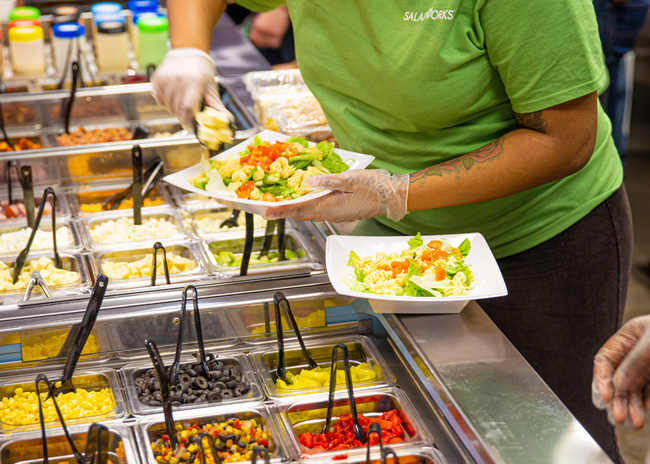In foodservice, there are many goals these areas can achieve. Speed of service is usually the number one objective. These areas can also help reduce labor load and provide additional revenue by expanding offerings. To best accomplish this, retail food offerings should complement the concept, appear fresh and look appealing. This also helps ensure that there is not a decreased perception of quality.
And, of course, the grab-and-go area provides the opportunity to showcase menu favorites like sandwiches, salads or signature items. The faster operators can increase throughput, the better the operational efficiencies. This is why it is best to position grab-and-go items where there are visual merchandising opportunities.
Location & Placement
There are many different ordering formats for retail areas, including walk up, which involves ordering and staying for pickup; end-to-end ordering, with ordering and payment on one end of the counter and order pickups on the other; and cafeteria style, which has customers moving down a line to choose ingredients then paying at the end. The style depends on what works best within the overall operation.It’s recommended that grab-and-go cases be strategically located in a high-traffic area, usually by a register or adjacent to the ordering area. A good rule of thumb is to place the bottled beverage case right before the register.
When retail food items are placed in and around the queuing area it’s easy to grab the attention of those waiting in line as well as those making their way to the point of purchase or register. If this section is placed after the point of purchase, customers would need to back track to purchase, creating a bottleneck in the service area.
With grab-and-go programs, there must be adequate space from the front door to the point of purchase to easily cue people who are waiting to order or pay. This is the case whether offering belly-up service or for those ordering and picking up at a different location.
Aisles are important; operators want customers to move through the line quickly but also prefer this area to look busy. Aisle width should be assessed to ensure customers can stand in front of a display case but also that others can get around them when needed.
Merchandising
Every concept begins with the menu. This will help determine how many shelves to dedicate to various grab-and-go items. There should be enough space to showcase products while still minimizing space between shelves for a look of abundance.Operators can get creative with backdrops within shelf displays. Adding beverages in colorful containers, including whole fruit and even making room to highlight ingredients that are in the salad, sandwich and other menu items helps tell a story. Merchandising accessories like baskets, colorful bowls and unique containers also provide eye catching displays.
Consistent replenishment is key to appealing grab-and-go displays. Having a dedicated stocker ensures that product is kept fresh, full and appealing. Choosing shallow cases and containers minimizes product spoilage by keeping food displays full but not overstocked. It is better to constantly replenish than have empty displays or cases that are so full that product quality is compromised due to extended holding times.
The most often ignored real estate is where products are packaged, labeled and staged for retail merchandising on the floor. If those items are cold like sandwiches or ready-to-eat meals, there is a need for refrigerated storage, ideally on rolling racks rather than reach-in units. Space is needed for different merchandising vessels. In addition, organized dispensers for ingredient labels and for one-off items will require space as well as a bar code printer that can generate unique labels.
An adequate amount of ambient and refrigerated storage must be built in for grab-and-go sales.
Signage
Signage plays a role in grab-and-go; going without it is like visiting a restaurant without a menu. People not only want to know what they’re buying but how much it costs.Cases should have a lip, shelf or clip system for signs. Both the top and bottom shelves can be used for creating or sending messages via signage.
Every jurisdiction has labeling requirements. While some cities require ingredients on every food item, others may not be as stringent. It is a good practice to let customers know what they’re consuming, particularly with allergens. When building a grab-and-go area, incorporating a good sticker machine and labeling technology goes a long way in minimizing labor but also in enhancing the customer’s experience.
Signage will also be needed to direct first-time visitors to what food is in the case and where to order and pick up items. In addition, signage provides the opportunity to educate customers on the offerings and ordering process.
In line with signage is the case presentation, which can make or break a grab-and-go program. Open cases in the traffic path are inviting as are black display cases, which help showcase food and help it pop.
Case lighting should be prioritized, as this will spotlight retail items. Lighting should be warm, not cool, with a Kelvin or color light temperature between 2400 and 2700.
Best Practices
Often overlooked are case mechanics, which can impact presentation. Remote compressors for display cases and reach-in coolers should be considered. Although pricier, these systems ensure hot or cold air isn’t blowing on customers and eliminate excess noise during operation.Item placement in grab-and-go areas makes a difference. Maps for all cases direct employees on where items should go, since customers need consistency to find what they’re looking for. It pays to strategically plan what will be in the top left corner and what’s in the bottom right. Keep in mind that the eyes buy, so higher level items will sell more than those on lower shelves.
Finally, merchandising appeal depends on the case being as clean as possible. Display cases should be emptied and thoroughly cleaned daily.



